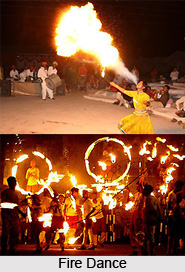 Fire dance is one of the unique dances performed in the desert region of Rajasthan state of India. This dance is the marvelous example of the Jasnathis of Bikaner and Chum"s lifestyle who are well known for their tantric powers throughout Rajasthan. Fire dance is very tricky and difficult to enact and is mainly performed by the Banjara community who are well versed with the art. Some of the dance steps involve awe-inspiring fire stunts wherein the performers dance by holding fire rods in their hands and filling up their mouths with kerosene.
Fire dance is one of the unique dances performed in the desert region of Rajasthan state of India. This dance is the marvelous example of the Jasnathis of Bikaner and Chum"s lifestyle who are well known for their tantric powers throughout Rajasthan. Fire dance is very tricky and difficult to enact and is mainly performed by the Banjara community who are well versed with the art. Some of the dance steps involve awe-inspiring fire stunts wherein the performers dance by holding fire rods in their hands and filling up their mouths with kerosene.
Performance of Fire Dance
The performance of fire dance requires dedication and immense practice. The dance takes place on a large ground, which is spread with live wood and charcoal. On this ground, the Jasnathi men and boys jump on to the fire with the accompaniment of drum beats. These drumbeats give a tempo for the performance. This music gradually rises and sets a dance in a fast tempo. At a certain point, it reaches at a crescendo, where the dancers seem to be in a trance like state. The dancers perform their actions as if they are blessed with a divine protection. The performance on a large bed of flaming coals is considered as a specialty of this region.
Some of the traditional folk dance of Rajasthan by the Banjara Community is also called the same. But this dance is completely different from the above-mentioned performance. Here, the dance is performed around the Fire. The person dancing usually takes two flamed sticks in his hands and fills up his mouth with kerosene oil. With the accompaniment of some dancing steps, he throws the oil over the lamps.
Musical Instruments of Fire Dance
This folk dance of Rajasthan is performed with the accompaniment of musical instruments like dhol, nagada, and dholak.
Performance of Fire Dance on Various Occasions
In general, the electrifying performance of fire dance can be observed at late nights of winter in Rajasthan. This dance is also performed during various occasions like Holi, Janmastami etc. This folk art form attracts viewers from various corners of the world during the occasions.



















